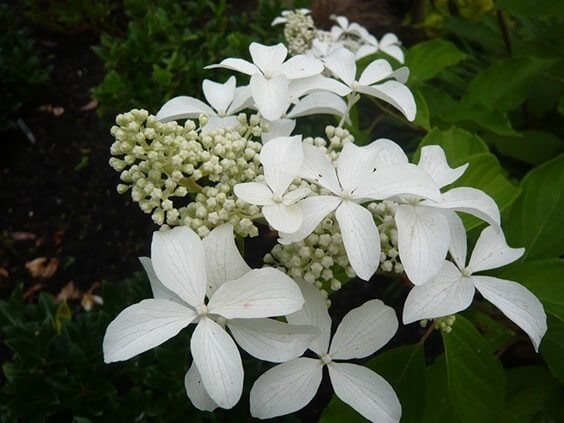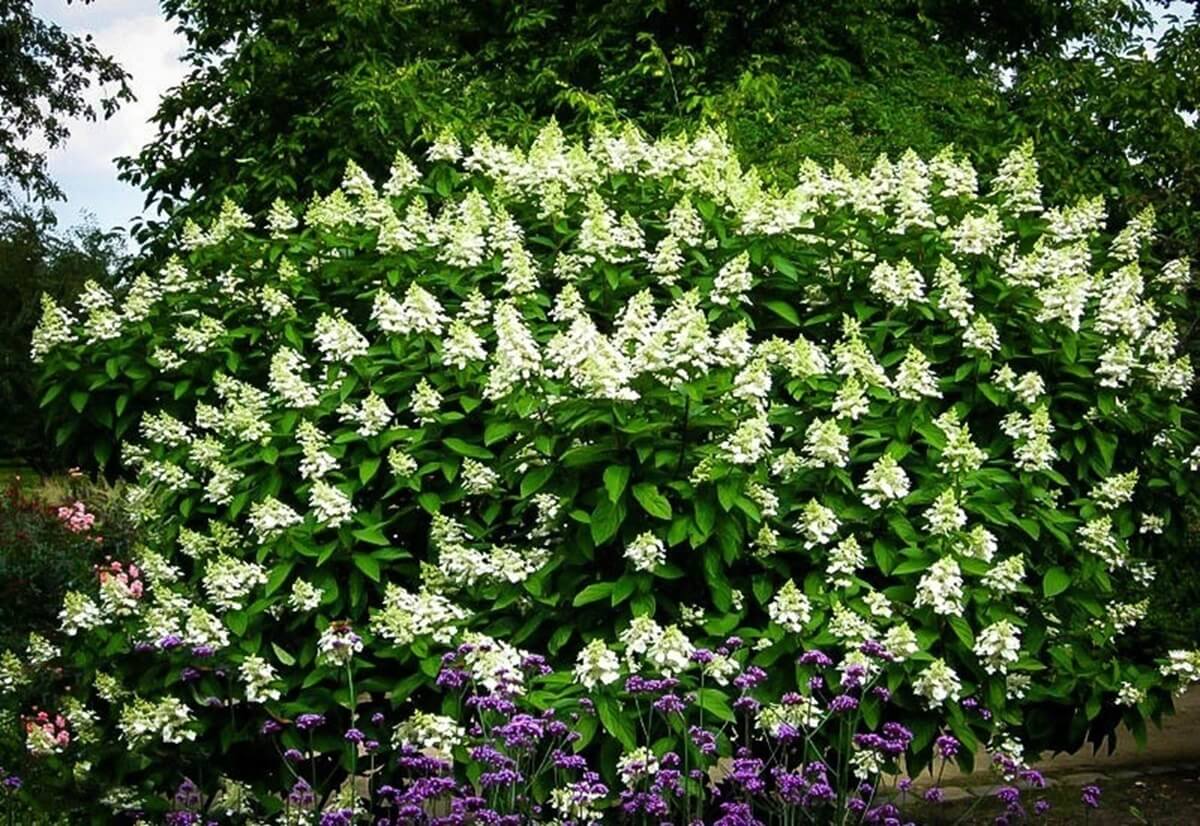Hydrangea is a shrubby perennial plant with a height of 0.6 to 1.5 m. The shape of the bush is funnel-shaped or cone-shaped. Depending on the variety, it can be either large-leaved or medium-sized leaves. Inflorescences – umbrella or panicle.
General information about hydrangeas
For the first time in European countries, hydrangea was brought to France at the end of the 18th century from an island in the Indian Ocean – Mauritius. The main participant and leader of the circumnavigation was Prince K.G. Nassau-Siegen, who named the flower after his sister, Princess Hortense. But science has a different opinion about acquiring the name of a flower. In Latin, gortensis (hortensis) is translated – “from the garden.” And since the shrub was discovered in the magnificent garden of the Mauritian governor, the name was quite appropriate.
A more detailed study revealed the love of the shrub for high humidity, so the plant received the scientific name Hydrangea. In Greek, the hydra is water, and angeion is a vessel.
The shades and color of the inflorescences of the hydrangea bush exist for every taste: from milky white to pink with a light green center.
Some varieties perfectly tolerate climatic changes in the middle lane and are absolutely unpretentious in care.
Types and Varieties of Hydrangea
In total, there are more than 40 varieties of shrubs in the world, of which 35 are common in Asia, 12 are cultivated in Russia, 2 types of varieties grow in the middle lane.
Two main types of hydrangeas are most adapted to Russian weather conditions:
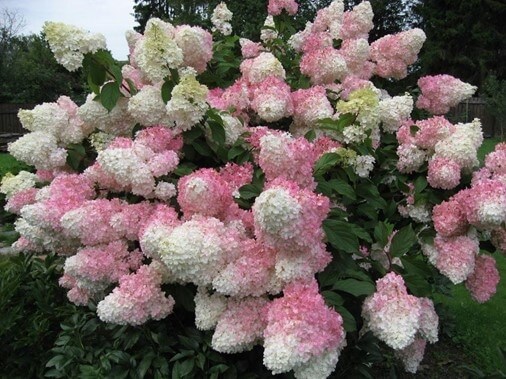
Paniculata hydrangea is a wide inflorescence panicle of a pyramidal shape. It has large sterile flowers and small fruits. By the beginning of flowering, the petals are white, gradually turning pink. By the end of flowering they become greenish. The bush reaches 3-3.5 m in height.

The tree of hydrangea is a variety cultivated in North America. The leaves are large, dark green and wide. The flowers are white, sterile and fertile. The plant itself is extremely whimsical and capricious. Does not tolerate direct sunlight, moisture-loving. Steadfastly endures the winter hut, frozen shoots are ways to self-repair.
Tree hydrangeas look best when grown as a tree.
A variety of varieties of hydrangea paniculata
In total there are 9 popular varieties of panicled hydrangea:

1. Limelight– greenish, lime-hued, densely planted flowers on pyramid-shaped brushes, can change color to pink in autumn. Bred variety from the breed “Little Light“
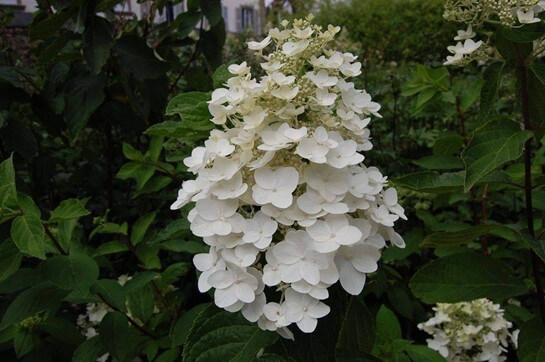
4. Kyusbu – non-hardy variety, cultivation of Japanese origin. Differ in a small number of sterile flowers, small in size.

7. Pinky Winky – pyramid-shaped openwork inflorescences, with sterile white flowers. By autumn, the flower acquires a purple hue.

8. Renby – the flowers have a rich pink hue; the inflorescences are conical in shape, relatively large.

9. Mega Mindy – large flowers predominantly cherry-colored. Long-term and abundant flowering is a feature of this variety.
In the middle lane, it is not recommended to breed the Tardivavariety, as it does not have time to bloom under the weather conditions and climate of Russia. For the same reason, the Floribundavariety should not be bred. According to some experts, this is the same breed of hydrangea with different names.
A variety of varieties of tree hydrangea
Tree hydrangea has 4 main varieties bred by breeding:

1. Annabelle – one of the most popular varieties of tree hydrangea. Jack Daniel – the breeder who bred this breed, characterized by a bush diameter of up to 3 meters with large inflorescences of white sterile flowers. Young bushes must be tied up because the panicles are very heavy.

2. Grandiflora – there is disagreement among botanists about this variety. Some attribute it to the hydrangea tree, others believe that the plant belongs to the paniculate species. The variety is characterized by spherical inflorescences of white color. It is known that American breeders managed to bring out new subspecies that are not afraid of harsh winters.

3. Invincibelle Spirit – the bush reaches 90-120 cm in height. The flowers are also quite large, bloom in a dark pink hue, later brighten significantly. Inflorescences appear on young shoots, so a thorough haircut can be carried out for a bush in the spring.

4. Inkrediball – a variety similar to the Annabellehydrangea, but the diameter of the flowers is more than three times larger. The entire inflorescence can reach up to 30 cm. The flowers, after opening a light yellow or greenish hue, turn white by the middle of the season, and turn green again by the time they fade. Flowering occurs on all shoots.
In addition to the above, there are the following varieties of hydrangea tree shrubs:

Hydrangea Petiolaris – hydrangeaof this species grows as a creeping vine. The flowering of the shrub occurs during the first two summer months, the bush itself, not including the length of the shoots of the vines in the middle lane, can reach 3 m. The inflorescences are in the form of corymbs of a white or pinkish hue. Prefers warm, humid and protected from direct sunlight places.
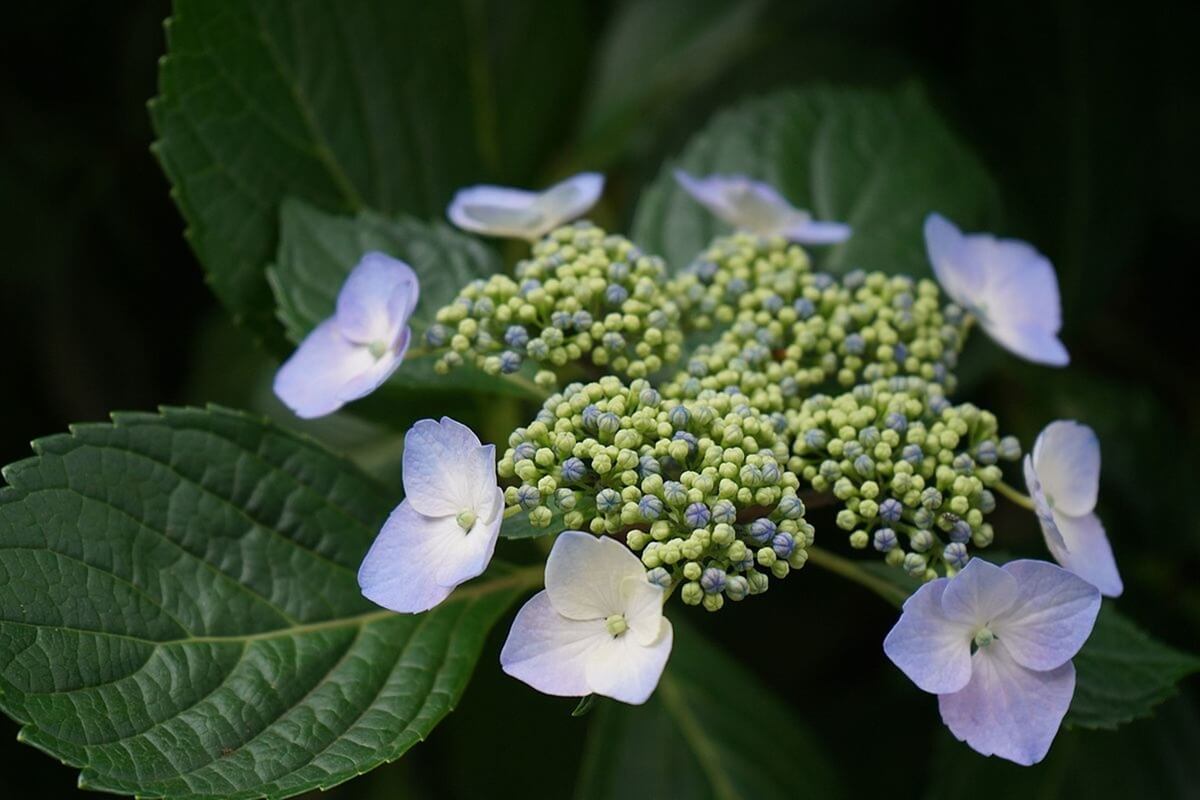
Hydrangea anomala is considered a variety of petiole hydrangea, but among botanists, it is customary to distinguish it as a separate species, due to inflorescences different from creeping hydrangea with rarer white flowers and less winter hardiness. Select popular varieties «Tiliifolia» and «Skyland`s giant».

Hydrangea quercifolia – a shrub plant that reaches a height of no more than 2 meters. Used primarily as an ornamental foliage species. The foliage has carved lobes, much like oak leaves. The variety is distinguished by a reddish, purple or cherry hue of the leaf plate in autumn periods. The inflorescences are quite large and collected in dense cone-shaped panicles up to 10 cm tall. The flowers are white. Not a hardy breed.
Bright neighbourhood: next to the hydrangeas in the foreground, ferns, bomalds, phloxes, spireas, geraniums, tiarella, badanand geykherawill look great.
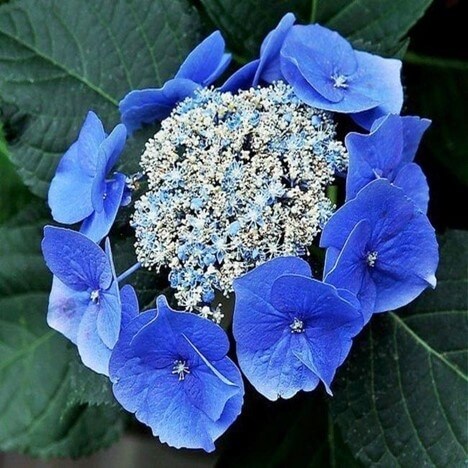
Hydrangea Serrata – low shrub up to 1.5 meters high. Flowering occurs in July and August with pale blue or white flowers. Inflorescences in the form of shields, the variety is not frost-resistant, therefore it requires shelters for the winter period.

Hydrangea heteromalla– shrub with a spherical crown up to 2 meters in diameter. Inflorescences up to 16 cm in diameter consist of white large sterile flowers. The flowering period is July-August, closer to autumn the flowers become purple. Shelter for the winter is necessary only for young shrubs, the species is winter-hardy. Of the whole variety of varieties of variegated hydrangea, Bretschneidershould be distinguished, which has larger inflorescences than the whole species.

Hydrangea cinerea – the species blooms in July-August, the inflorescences are corymbose, the flowers are small and white, it freezes in severe frosts, but is capable of self-healing. This species requires highly acidic soil.

Hydrangea sargentyana – shrub with huge leaves reaching 25 cm in length. The leaf plate has abundant pubescence. The shoots cannot stand the climatic conditions of the middle lane, so they freeze in the winter, but the shrub produces new shoots up to 1.5 meters long during the season. Cultivated variety “Sargent” comes from China. Most often, flowering with white or slightly pinkish flowers is sterile and fruitful, but sometimes it can bloom with bright rich blue or purple flowers. Inflorescences reach 15 cm in height and look like a cone in shape.
Hydrangea makrophylla) – this type is the most popular among gardeners.. In addition to large leaves and inflorescences, the species has the brightest and most diverse tones of flowers. The most popular varieties are:
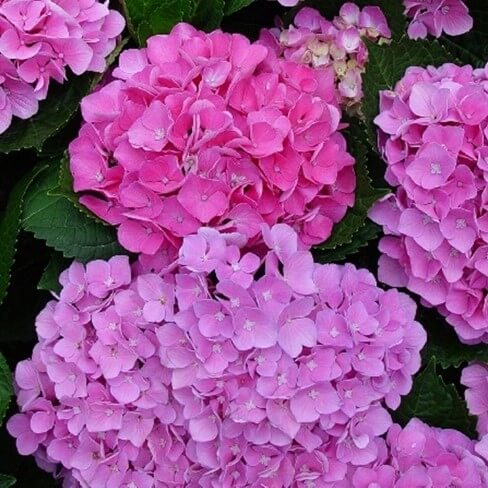

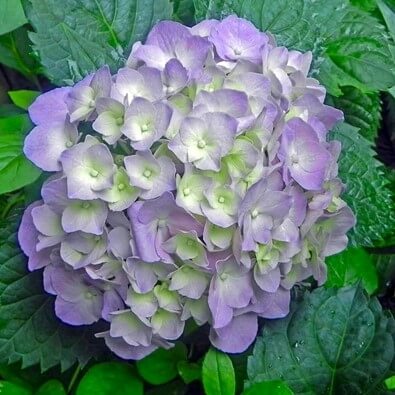

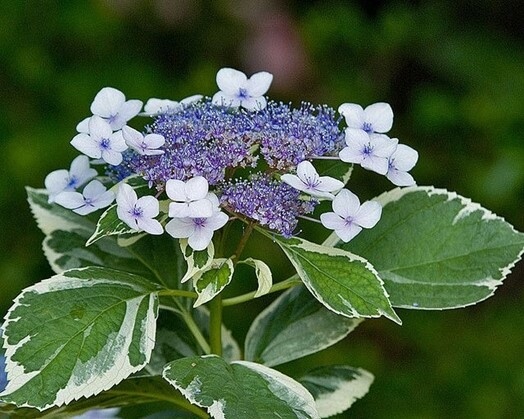
Often the shade of a hydrangea flower depends on the acidity of the soil. The lower the acidity, the bluer the tone, the higher the acidity, the pinker the color.
Hydrangea shrub care and agricultural technology
Hydrangea is a rather unpretentious plant, but in order for the shrub to feel good and delight with lush inflorescences, it is necessary to create an atmosphere favorable for it.
Landing and care
For planting a shrub, it is necessary to choose semi-shady and open places. For shrubs with bright inflorescences, it is better to plant where direct sunlight does not fall at noon. Soil drainage should be taken care of in advance. This is especially true for species that are not resistant to cold. Most types of soil are suitable for hydrangeas, but the ideal option is loose, moist, rich in micro and macro elements, moderately acidic soil. In order for the Ph balance to be equal to 5-6, which is the ideal acidity for hydrangeas, it is necessary to add peat to the substrate.
pruning
Hydrangea shrub pruning is carried out in early spring. The bush is given the necessary shape, weak and frozen shoots are removed. For some varieties that produce inflorescences on young shoots, a capital haircut is not forbidden in order for the flowering to be lush.

In autumn, faded inflorescences are cut off.
For hydrangeas, which are characterized by flowering on old (last year’s) shoots, it is recommended to carry out only sanitary pruning.
If pruning is not carried out, the shrubs become too dense, which leads to a lack of trophism and negatively affects flowering. In addition, with the help of pruning, the height and shape of the hydrangea is adjusted.
top dressing
In order to provide the bush with dense foliage and splendor of inflorescences, the hydrangea must be watered abundantly, especially in hot and dry periods, and fed.
In the spring, when the foliage has not yet blossomed, it is necessary to prune the plant based on the type and variety of shrubs. After that, the hydrangea is fertilized with nitrogen-containing dressings to help in the production of chloroplasts. Thus, bright and dense foliage is provided.
In May – June, full-fledged mineral complexes are introduced into the soil. But when choosing top dressing, it should be remembered that hydrangea is a calcephobe, and fertilizers containing lime and chloride compounds are not suitable for shrubs. If calcenates get into the soil where hydrangeas grow, then the shrub will get sick with chlorosis.
Due to the fact that calcium hydrangea is also a chlorophobe, it is necessary to think over the neighborhood. The best symbiosis for the hydrangia shrub is the rhododendron. It will help increase the flowering time of hydrangeas and will not fade for a long time.

When buds appear on the bush, the plant must be fed with complex fertilizer again, since flowering requires additional nutrition. It is desirable that complementary foods contain a large amount of potassium and phosphates.
The third time the shrub is fertilized at the end of August with potassium sulfate. Also, you can use an infusion of manure and superphosphates.
Mulching the substrate is a necessary procedure that should be done at least 2 times a month. Sawdust of coniferous trees and peat are used as mulch.
Wintering
In the middle lane among gardeners, varieties that easily endure winter periods are more popular. But there are also types of hydrangeas that are not resistant to frost. So that such a plant does not die during a cold, it requires shelter.
Covering shrubs in open ground is a rather difficult task. If the cover is laid too late, the shoots will freeze; if the plant is opened too early, the buds will freeze. And all this will negatively affect flowering. If the hydrangea is not covered tightly enough, the shrub may even die.
The best option is to grow the plant in a pot. Thus, it will not be difficult to transfer the hydrangea to the greenhouse in the fall, and lower it into the basement for the winter so that the shrub can rest.
Transplanting hydrangea bushes
Hydrangea perfectly tolerates transplantation throughout the entire vegetative period, but leading experts in the field of dendrology recommend planting and transplanting shrubs in the spring and autumn. At this time, there is less risk of damaging the thin suction roots.
A transplant is necessary for overgrown shrubs in order to thin them out.
Before digging a bush for transplantation, the soil should be poured abundantly with water to form an earthen clod that will adhere tightly to the roots, protecting them from mechanical damage.
The next step is to dig around the perimeter of the hydrangea. In this case, it is necessary to observe an indent of 25 cm from the basal branches.
Step-by-step video instruction for transplanting hydrangeas:
In order for the hydrangea to feel good in a new place, it is recommended to pour up to a third of peat mixed with compost into the transplant hole. The plant is placed in a prepared hole and sprinkled with soil.
The neck of the root system should not be deepened; excessive digging can cause the root system to rot. The distance between hydrangea bushes should be at least 1 meter.
After the plant is planted, it is necessary to shed the hydrangea abundantly with water. If the substrate settles, it is necessary to add soil.
It is best to repeat the strait several times to remove the air dome in the roots of the bush.
After the transplant, the shrub must be mulched with sawdust, crumbs of the bark of coniferous trees or litter of needles. Mulch is essential to retain moisture.
While the hydrangea takes root in a new place, it is best to place an awning over the bush, which will scatter the sun’s rays. Such a diffuser can be gauze or spunbond.
Care in the first year after transplantation should be more thorough. Regular watering is recommended to be done with additives that stimulate growth and root formation.
Reproduction of hydrangea shrubs
Propagation of hydrangeas requires some experience or deep theoretical knowledge on this issue. If you are not confident in your abilities, you can always buy a seedling from a nursery. But at the same time, you lose the opportunity to get a plant that you have grown with your own hands. In addition, the process itself is quite an interesting activity and invaluable experience. It is also worth adding here that the cost of hydrangeas from the nursery is not small.
In total, there are 5 ways to propagate hydrangea shrubs:
Reproduction by layering
This method should be done in early spring, before the buds on the branches bloom.
The soil around the shrub must be loosened and leveled. Then radial furrows are laid, according to the type of rays. Their depth should not exceed 2 cm.
In each beam of the furrow, shoots extending from the lower part of the bush are laid, then we fix each layer with horns so that the shoots do not straighten.
In order for the roots on the shoots to appear faster, dendrologists use a wire constriction: in front of the first developed bud on the layer, they make a winding in two or three turns. In the process of growth, the wire will cut into the process and the first roots will soon appear at this place.
By the end of summer, with proper care of the shrub, young shoots will appear on each layer.

As soon as the shoots grow to 20 cm, they will need to be spudded every decade. Subject to the care instructions, in October the shoots will be approximately half a meter high.
The next step is to dig up the young seedlings and separate them from the main bush. The young shoots are dug into the ground, and in the spring they are planted in the garden.
After a year, grown bushes can be planted in a permanent place.
Reproduction of hydrangea cuttings
The most common propagation method among gardeners is to grow new hydrangea bushes with green cuttings.
Cuttings are carried out at the moment buds appear on the bushes, because during this period the trophism on leafy branches reaches its peak.
If cuttings are planned to be carried out from old bushes, then it is necessary to carry out rejuvenating pruning in the spring.
It is more effective to cut the cuttings in the early morning, when the maximum concentration of moisture in the branches.
Immediately after pruning, the shoots must be placed in a shady place in the water. The upper part with the bud is cut off, the lower leaves are removed. The upper leaf plates are shortened in half. After that, the cuttings are placed in water with growth stimulants.

In this solution, it is necessary to keep the cuttings in a dark place for 2 hours. This will contribute to the formation of callus, the biological thickening necessary for the appearance of roots.
Instead of a root former, you can use ordinary honey. You need to dissolve a teaspoon of the product in a glass of water.
The next step is to plant the cuttings in a 2:1 mixture of peat and sand. To make the root formation process faster, the cuttings are covered with banks: the created condensate will humidify the air around the shoot.
During the dry season, cuttings are watered once a day. In about a month, rooting will occur, the signal of which will be the appearance of young leaves.
In the cold season, young shoots are tightly covered with fallen leaves, which, when rotting, will generate heat.
Reproduction of hydrangea by dividing the bush
This method is applicable when transplanting and thinning an already adult shrub. The hydrangea is dug up as described in the “transplant” section of the article, and all clods of earth must be carefully shaken off so that the root system is visible.
After that, the bush is cut with an ax or cut with a knife. At the same time, each of the separated parts should have renewable buds that will help the plant become an independent shrub.

Reproduction of hydrangea seeds
Reproduction by seeds is effective only for plants that are of natural origin. Breeding varieties either do not have fruitful flowers, or lose the characteristics of their variety.
Seeds do not require any preparation before planting, they can be planted immediately in a pot. It is necessary to maintain high humidity in the soil in order for the seeds to germinate.

Sprouts appear about 20 days after planting. After the appearance of green shoots, the sprouts grow within two years. By the time of planting, the shrub should be at least 40 cm.
In the third year, the young hydrangea is ready for planting in a permanent place.
Reproduction of hydrangea offspring
Young shoots that grow from the main bush take root well, but this method, despite its effectiveness, requires extreme caution: when weaning young growth from the mother bush, there is a risk of damaging the root system of the parent.

To separate the offspring from the mother hydrangea, it is necessary to carefully remove the top layer of soil, determine how safe it is to remove the shoots and carry out the separation.
We plant young shoots on the bed for growing, and after a year you can transplant new shrubs to the main place.
Diseases and pests of garden hydrangea
Not only people, but also plants are susceptible to diseases. The most important thing is to eliminate the cause of the disease in time.
Hydrangea is little susceptible to any diseases or pests, but with improper care or under the influence of external factors, even this unpretentious shrub can be on the verge of death.
Hydrangea diseases
Hydrangea shrub disease can be fungal and viral in nature. If it was possible to correctly identify the pathogen, then the treatment will bring positive results.
Fungal diseases of hydrangea and methods of treatment

white rot
The white rot fungus affects the root system of the shrub, while the hydrangea on the leaf plates is covered with a mossy white coating. The fungus does not give the shrub sufficient nutrition, which is why the hydrangea begins to slowly die. After some time, foci of necrosis appear in the form of black spots on the leaves.
The most unpleasant circumstance is that fungal diseases are extremely contagious.
You can identify the disease in the early stages by young shoots that will darken.
The most effective treatment for candidiasis is treatment with antifungal fungicides.
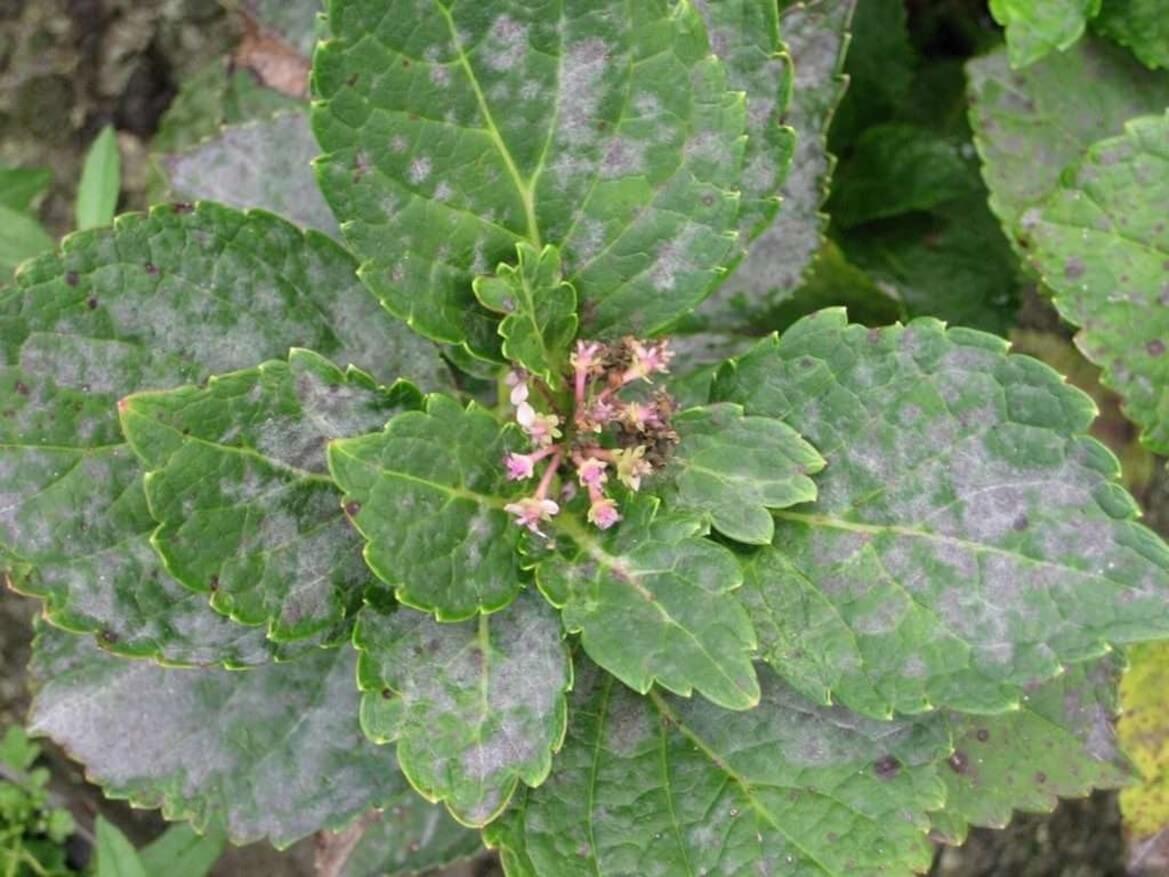
gray rot
Gray rot fungi appear with excessive watering. The wateriness of the sections of the leaf plate leads to softening of the tissues and the appearance of a gray coating. In dry weather, the damage sites dry out and holes form in their place in the leaf plate.
To overcome the disease, first you need to remove diseased leaves and shoots. Then the bush is treated with fungicidal agents. As a preventive measure, the treatment is repeated twice with an interval of 20 days.

Fusarium or wilting
The symptomatology of the disease is the “causeless” wilting of the plant. In fact, the problem lies in the fungus that has settled in the roots. Mycelium softens the root system, penetrating deep into the plant. Hydrangea loses trophism and gradually dies.
The solution to the problem is fungicidal agents that need to be sprayed on the shrub.
An effective remedy is an infusion of celandine and nettle, which can be used to water the plant both as a treatment and for prevention.

Septoria
A characteristic sign of the disease are brown spots on the leaf plate. In a neglected form, the disease will spread, so it is necessary to take measures in the early stages.
Treatment is carried out by stopping the disease, that is, the affected areas are removed. After that, the hydrangea should be treated with a copper-based solution.

Peronosporosis
Another name, more popular among the people, is downy mildew. Warm and humid climatic conditions can provoke the appearance of candida of this type. Greasy spots appear on the leaves, over time, the affected leaves turn brown.
To heal the disease, hydrangea must be treated with glandular compounds with the addition of soap.

powdery mildew
A characteristic sign of the disease are yellow spots on the leaf plate, which later turn brown. If the disease is not treated, the hydrangea will not survive the winter.
Treatment is carried out with powerful fungicidal compounds.
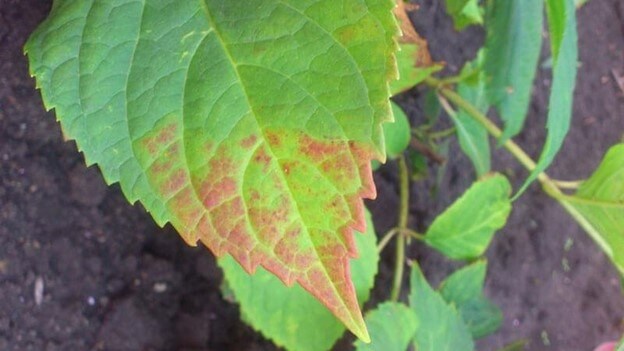
Rust
Hydrangea is covered with a rusty coating. In most cases, the cause is excessive planting density of shrubs.
An effective remedy is copper oxychloride, but it is not applicable to hydrangeas, due to the presence of chloride substances. Therefore, dendrologists recommend the use of fungicidal formulations.
Viral diseases of hydrangea and methods of treatment
The causative agents of this type of disease are viruses that infect hydrangea.
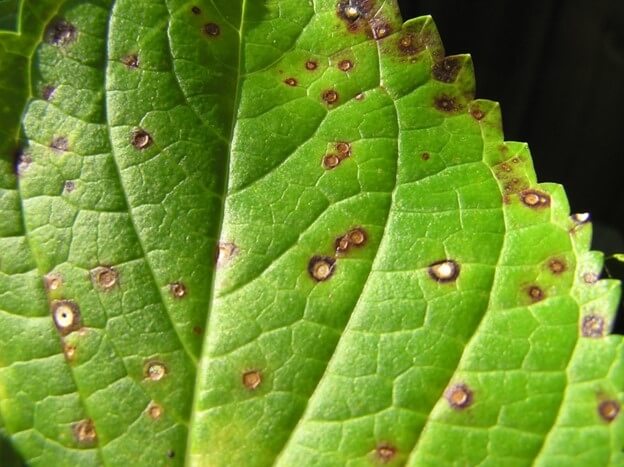
ring spot
The most common disease, which is characterized by brown spots “burning through” the leaf plates through. Eventually the plant dies.
The ring spot virus cannot be cured, it is a hereditary disease. Therefore, it is important to take healthy seedlings. If the mother hydrangea was sick, then the offspring will also be a carrier of ring spot.
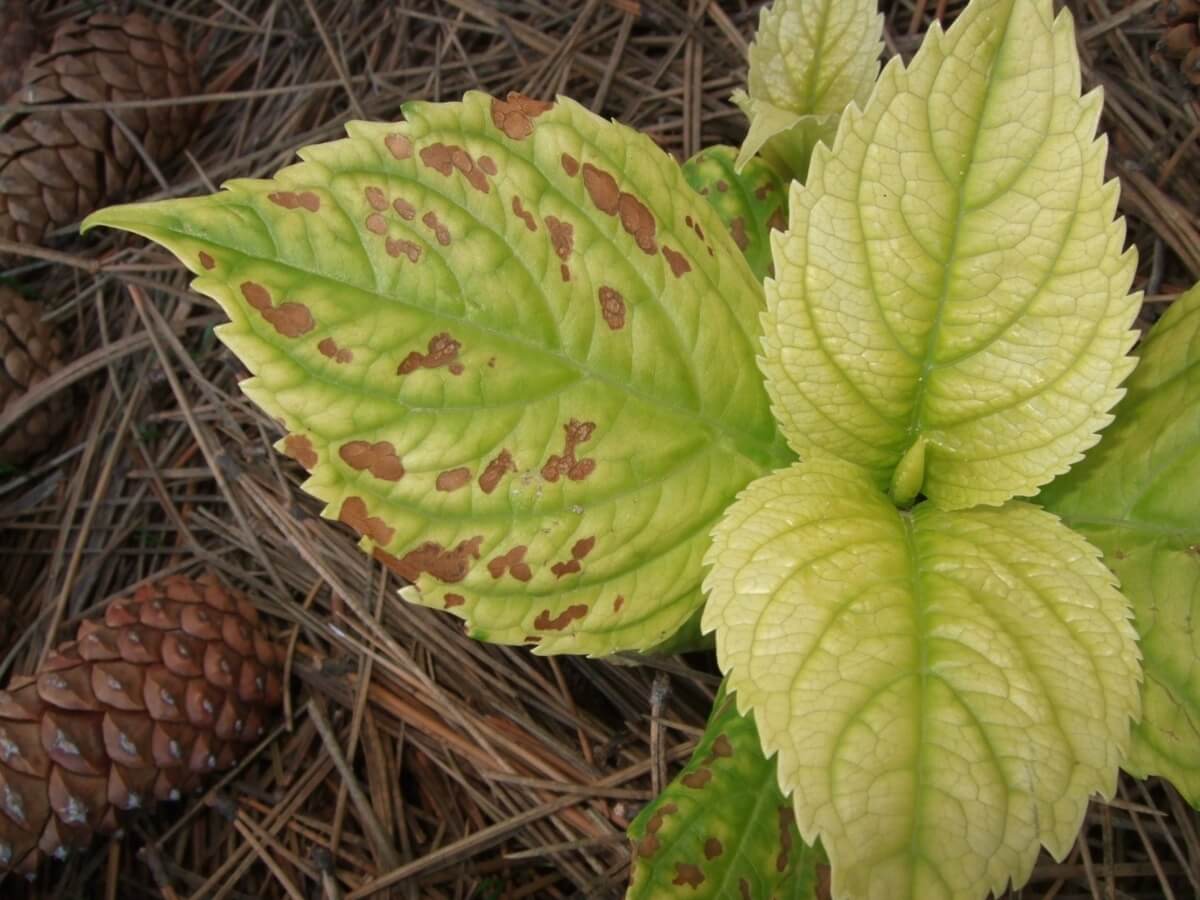
Chlorosis
A disease that occurs when metabolic processes are disturbed or when there is a lack of iron in the soil. Hydrangea suffers from chlorosis if an inexperienced gardener uses calcium fertilizers and fertilizing with chloride compounds. Hydrangea suffers from chlorosis if an inexperienced gardener uses calcium fertilizers and fertilizing with chloride compounds. A characteristic feature is a light leaf plate and dark veins.
As a treatment, it is necessary to feed the shrub with chelated glandular compounds.

Dry blackening
The disease is manifested by brown spots that lead to the withering of the shrub. The reason is too hard water. Before watering, water must be defended, in which case the problem will be solved by itself.

Wet blackening
The reason for the soft and dark leaves on the shrub is in the nature of an unfavorable atmosphere. This is excessive watering, temperature changes, too heavy soil and other reasons.
parasites on hydrangeas
Parasitic organisms are rare on the hydrangea shrub, but it is wrong to exclude the danger from insects to the plant.
Aphid. The insect gnaws the shoots and drinks the juice from the plant, which can lead to deformation of the leaves and yellowing. In addition, it creates favorable conditions for fungal parasites.
Aphids can be washed off with a stream of water, but this is effective with a slight dominance. Running cases can only be corrected with insecticides.
Gall nematode. In addition to the fact that nematodes devour the bush, they leave a poisonous trail behind them, which can cause the hydrangea to die.
The most effective is the tool “Karbofos”. But the condition for the use of the product is the absence of direct sunlight, which reduces efficiency.
Spider mite. Small arachnid, the appearance of which is characterized by the thinnest cobweb and yellow spots on the leaves.
Small arachnid, the appearance of which is characterized by the thinnest cobweb and yellow spots on the leaves. If there are many parasites, the use of insecticides is recommended.
Snails and slugs. They pose a threat to overwintering covered plants. Parasites are planted where there is a denser planting of shrubs.
Parasites are planted where there is a denser planting of shrubs.
Leaf beetle. Leaf beetle larvae eat all parts of the plant, the greatest danger is presented by parasites wintering in the roots of the bush.
The only effective means is manual collection and digging of the soil. The eaten leaves must be collected and burned.
Hydrangea: benefits and harms
Among all the varieties of varieties of hydrangeas, only the tree hydrangea is considered a medicinal plant. Among all the varieties of varieties of hydrangeas, only the tree hydrangea is considered a medicinal plant.
The rest of the species are purely decorative.
- Vitamin complex A, B, C, E.
- Glycosides are an adjunct to the restoration of the immune system.
- Alkaloid substances – are part of painkillers.
- Saponins – prevent the formation of kidney stones.
- Coumarins – regulate the balance of water and salts.
- Carbohydrates – improve metabolic processes.
In addition, the plant is characterized by anti-inflammatory, diuretic, antiviral, antiparasitic and sedative properties.
If there are positive properties of a medicinal shrub, then there will certainly be negative ones. Any medicine is a poison in small doses, so the abuse of traditional medicine without professional advice can lead to many unpleasant consequences:
- redness and rash;
- A sharp decrease in systolic and diastolic pressure;
- causeless shortness of breath
- The body’s addiction to the auxiliary functions of the diuretic component, which, if canceled, can cause kidney failure and edema.
In addition, the use for medicinal purposes is contraindicated:
- During pregnancy and during breastfeeding;
- Childhood;
- Intolerance of constituent elements.










